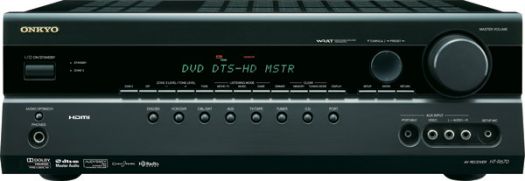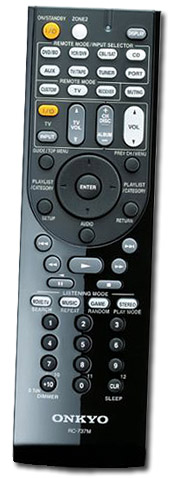Low Rent in the Home Theater District
As the owner and frequent user of an Onkyo receiver, I was curious to see what The Big O was up to in the Home Theater in a Box (HTiB) category. Their standalone multichannel receivers enjoy a well-earned reputation for value and performance, so bundled with the right speakers they might provide an attractive solution for the Blu-ray enthusiast eager to explore his full audio potential. So, would the Onkyo HT-S6200 Home Theater System fill the bill?
The contents of the rather big carton can be divided into two sections, namely the HT-R670(B) 7.1-Channel A/V Surround Home Theater Receiver and HTP-670(B) 7.1-channel Surround Home Theater Speaker System. These speakers are surprisingly large for a HTiB (the six satellites share the same dimensions, give or take .3 inches) yet the four surrounds are surprisingly light for their size, with a hollow ring when you knock on them. (But for a hammer and a good explanation I would have "examined" further...)
The bookshelf-sized/styled surrounds each utilize a single three-and-a-quarter-inch full-range driver, while the more versatile left/right/center house dual four-inch woofers and a one-inch balanced dome tweeter within the glossy black plastic cabinet. The 230-watt powered bass-reflex subwoofer is front-ported, with a ten-inch downward-firing cone woofer. This is actually one of the largest subs I have ever seen included in a HTiB package, with a wooden cabinet big enough (and strong enough) for me to sit on.
The receiver boasts the same efficient styling as many recent Onkyo models, again lighter than it might appear at first glance, and pared down in some subtle ways to help it achieve its high-value price point. While conveniences such as an onscreen display (OSD) and performance enhancers such as video upscaling would have been welcome, one area in which the HT-R670 is certainly not lacking is its supported audio formats. Blu-ray's lossless favorites Dolby TrueHD and DTS-HD Master Audio decoding are here, along with Dolby's brand-new Pro-Logic IIz surround sound format, adding "Front High" channels. Onkyo also throws in their own Game and Music Optimizer modes.
What It's Got, and Not
Additionally, some handy acoustic correction is built in. The Audyssey 2EQ room correction and calibration system works with the enclosed microphone to customize the sound for a specific room, while Audyssey Dynamic EQ and Audyssey Dynamic Volume allow users to further tailor the performance to any particular needs or tastes. Around back is Onkyo's exclusive Universal Port (U-Port) to connect the included UP-A1 iPod dock to pass both audio and video from an iPod or iPhone to the home theater. Unfortunately, the aforementioned lack of upscaling to higher resolutions means we will have to run a composite video cable between receiver and TV to watch iPod video, although audio-only choices are plug-and play over any audio hookup. The included RC-737M remote enables some iPod control from across the room. The U-Port also accepts Onkyo's HD Radio tuner, sold separately.

Speaker and component connectivity too is quite generous. In addition to a quartet of HDMI 1.3a inputs for the latest high-def gear, the rear panel serves up multiple component video, composite video, digital and analog audio ins and outs. Speaker-wise, the Surround Back Left/Right binding posts can be configured to run either surrounds or the Front High channels for Dolby Pro-Logic IIz, although I should make clear that the necessary speakers for this application are not included with the HT-S6200 package, unless you opt to use the front height channels instead of the rears, which may make sense in your particular room. These same terminals can also be used to bi-amplify the left/right mains, if we upgrade to more elaborate loudspeakers. Dedicated spring-clips are supplied for the Front High connection, although this in turn can be reconfigured to drive stereo to a second zone of the house.
Happily simplifying the physical installation process are the color coding of the speakers (well, the spring clip connections on the back), the seven lengths of speaker cable and the binding posts on the receiver itself. The center channel has a tapered shell virtually identical to its siblings, distinguished by the horizontal placement of its Onkyo nameplate, but this means it will point slightly upward when resting on a flat surface above or below the TV. Adhesive rubber feet are included and I suggest using them as these little hard plastic speakers do not handle their own inherent vibration very well. More than once the satellites shook themselves off of their resting places during my testing, and I didn't even play any earthquake scenes.
The Sound of 1,200 Watts
Since not everyone performs the automated room calibration, despite its ease, we tested the HT-S6200 HTiB as-is, right "OotB" (out of the box) first, then again post-Audyssey. All told, it pumps out a maximum 1,200 watts for its 7.1 channels. The volume reading goes from zero to "80," and I ran my first series of demos at "40," with the independent subwoofer knob also set at 50% power. These settings were surprisingly quiet, although bass at least was ample. Nudging up to 60 was generally adequate for big action movies, although treble frequencies start to sound a bit too bright. The sub also needs to be adjusted accordingly, as it can begin to sound unnaturally boomy when driven too hard. Anything much above a master volume level of 60 begins to overload the system, introducing obvious distortion--some serious--before we even hit 80.
The surrounds of the DTS-HD Master Audio 5.1 go-to Blu-ray Master and Commander: The Far Side of the World Blu-ray proffered excellent detail but lacked the overall presence and power I've heard delivered from this title on other systems. With the proper combination of subwoofer level and master volume however, bass truly kicked. The Uncompressed PCM 5.1 track of The Patriot Blu-ray again maintained the finer points of the track without bowling me over with the overall clarity or visceral impact.
I also gave a spin to a pair of 7.1-channel platters to hear the true potential of the HT-S6200: Paramount's Star Trek VI: The Undiscovered Country, a recent Dolby TrueHD 7.1 favorite, (from the Star Trek Original Motion Picture Collection, and due 9/22 as a single disc) and Universal's Hellboy II: The Golden Army. Neither the Dolby TrueHD nor the DTS-HD Master Audio track, respectively, exhibited any major flaws, but even so they did not gel into the thrilling soundfields I know that they can be when optimally reproduced. I place the blame on the speakers, specifically the "full-range" drivers of the side and back surrounds, which exhibit noticeably, troublingly limited dynamic range. Onkyo's strength is more within the realm of A/V receivers, so that's probably where most of our $699 is going, some to the big wooden subwoofer certainly, but the satellites are somewhat disappointing in design, build and performance.

To be fair, performing the Audyssey room calibration with the enclosed microphone improved matters, taking into account various environmental factors of my particular home theater and making the 7.1 come together more as a singular experience. Interestingly, I needed to adjust the master volume more than usual between movies to achieve acceptable levels from title to title. The Patriot for example needed to be turned up significantly louder than Master and Commander.

Taking a suggestion from Dolby, I tried the first scene of Ratatouille and the value of front-high channels quickly became apparent during the rainstorm. While the top/bottom directionality is more subtle than the front/back that we're more used to, the four speakers working together did impart an extra measure of credibility, rendering a world larger than the dimensions of my TV screen. I suppose that five speakers (including center channel) now qualify the front soundstage as a "wall of sound," and the possibilities there make Dolby Pro-Logic IIz certainly worth exploring. At the very least, PLIIz on a receiver is a "nice to have" so when actual PLIIz-encoded material comes along you'll be ready.
Switching from HDMI at 1080p to component video at 480i input from the Blu-ray player (and therefore a component video output from the receiver to the TV as well), I ran the usual battery of Silicon Optix HQV Benchmark DVD tests to assess the HT-R670's deinterlacing performance. It packs Faroudja DCDi (Directional Correlational Deinterlacing) Edge technology in its chips, capable of converting interlaced video signals to progressive scan, in an effort to reduce artifacts from lesser-quality images. It works, with a marked reduction (not elimination) of jaggies, on a par with the video performance of Onkyo's standalone TX-SR606 receiver. Worth considering is the step-up Onkyo HT-S7200 system which does incorporate upscaling of component and composite video sources to 1080i, in addition to more inputs and a superior complement of loudspeakers.
Turn-Ons:
Turn-Offs:
Final Thoughts
The quality, performance and versatility of the central receiver is undeniably impressive, especially as part of a complete package at such a reasonable price point. And if for any reason we grow tired of the matching speakers, the upgrade path is built-in, making the Onkyo HT-S6200 Home Theater System an excellent starting point for a high-def rig.
Where to Buy:
Features/Specifications of the HT-S6200
Connectivity (Rear-Panel):
Speakers:
Manufacturer's Contact Information:
Onkyo USA Corporation
18 Park Way
Upper Saddle River, NJ 07458
Tel: 800 229-1687
Web site: www.onkyousa.com
Where to Buy: Onkyo HT-S6200 Home Theater System (Amazon.com)
| Overall | |
|---|---|
| Value | |
| Performance | |
| Features/Ergonomics |